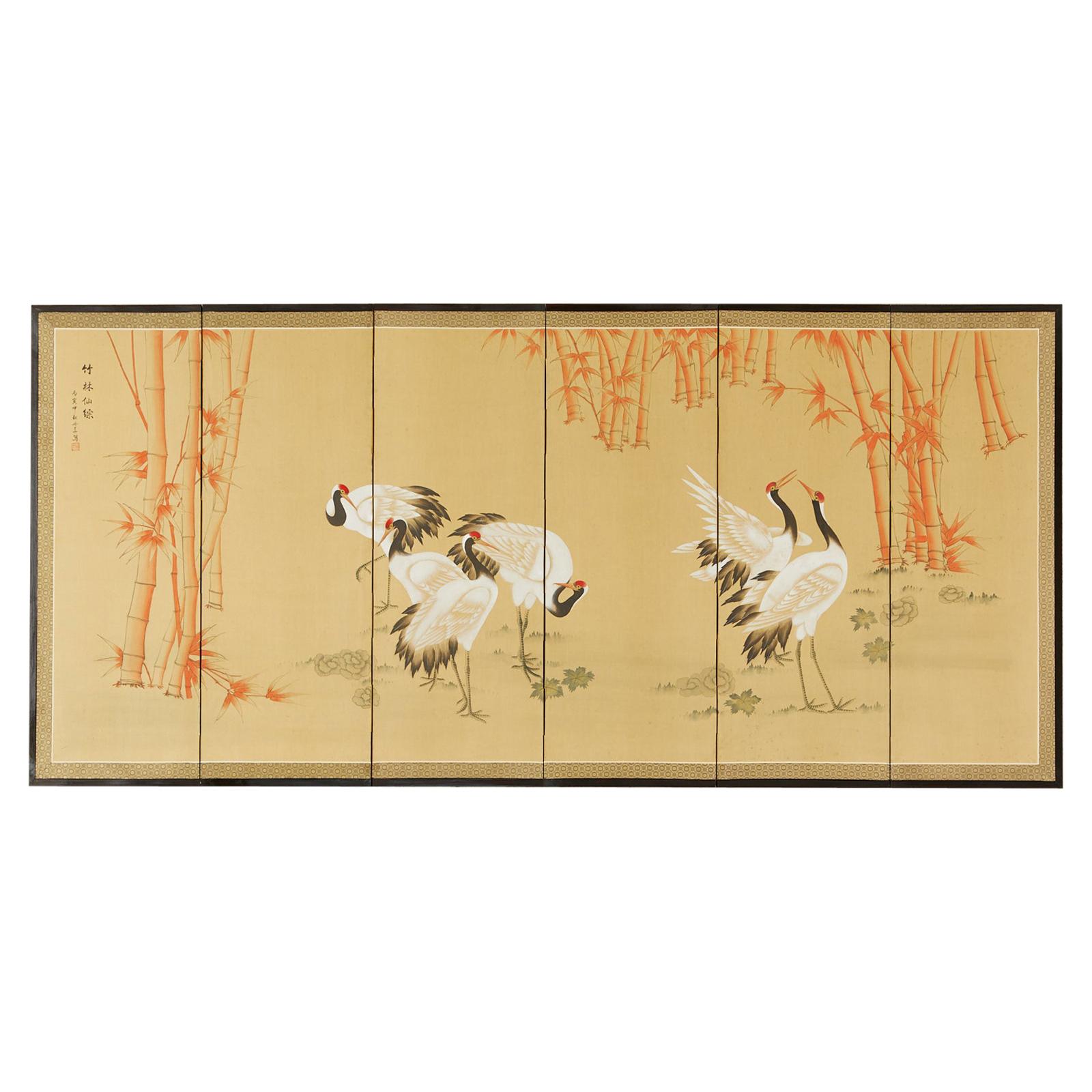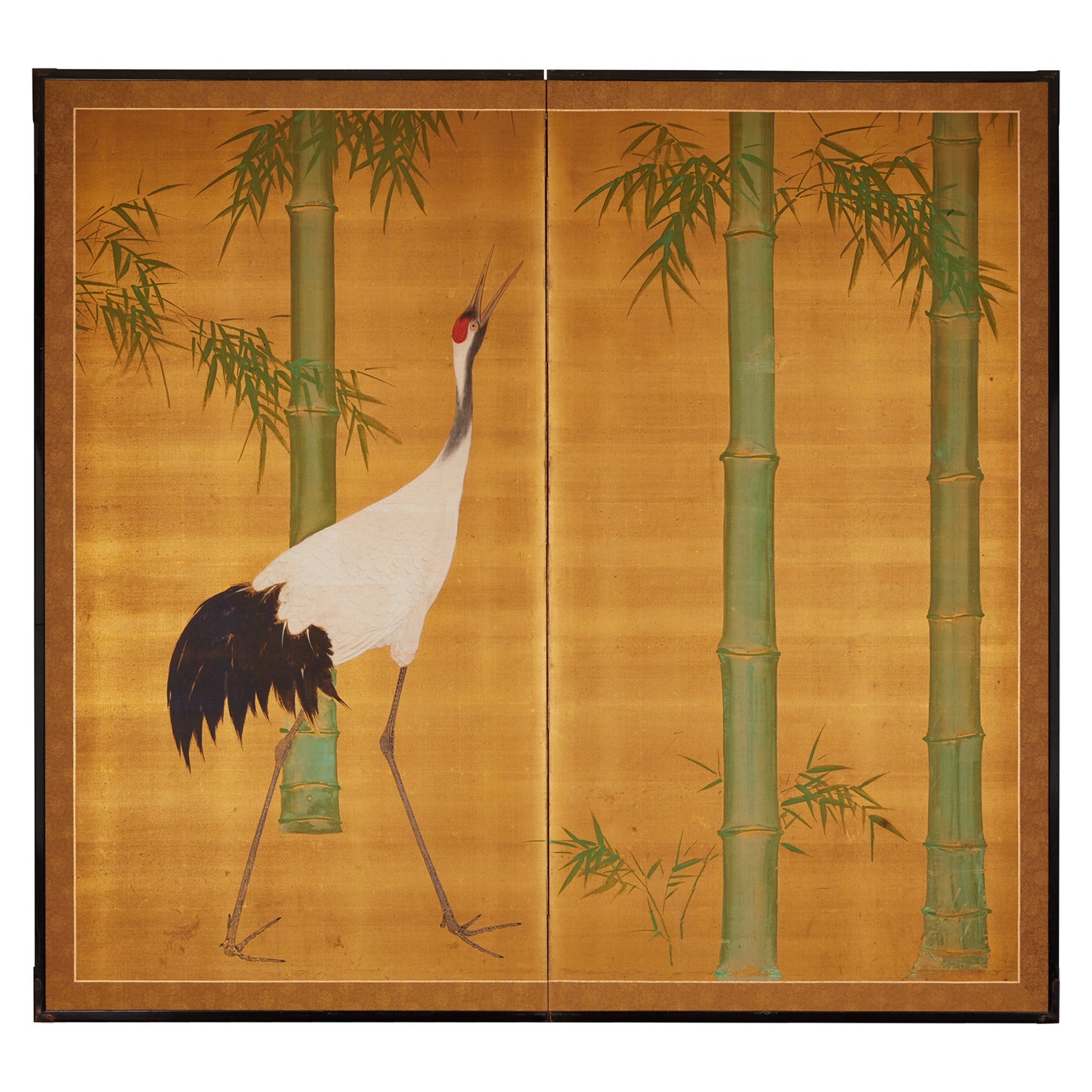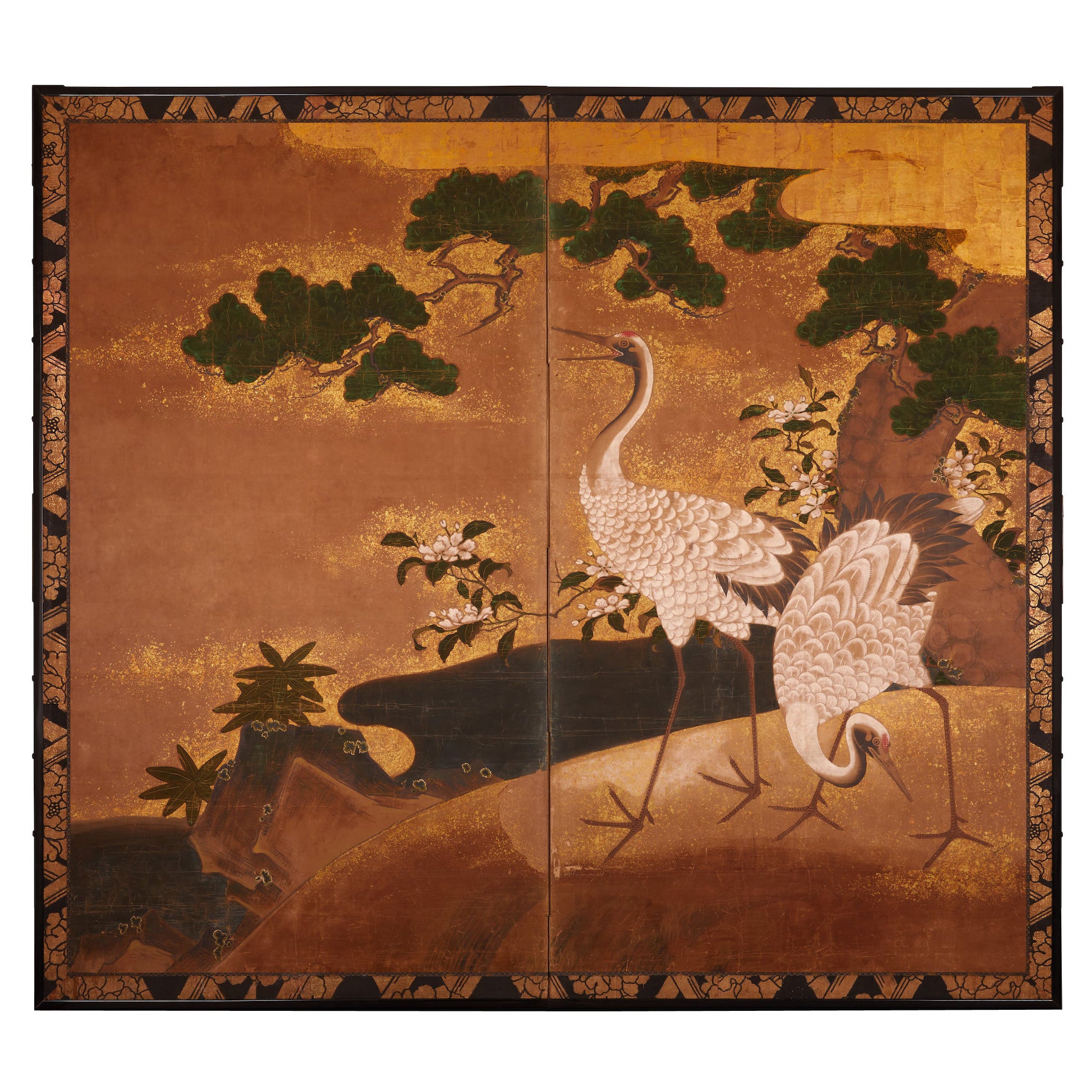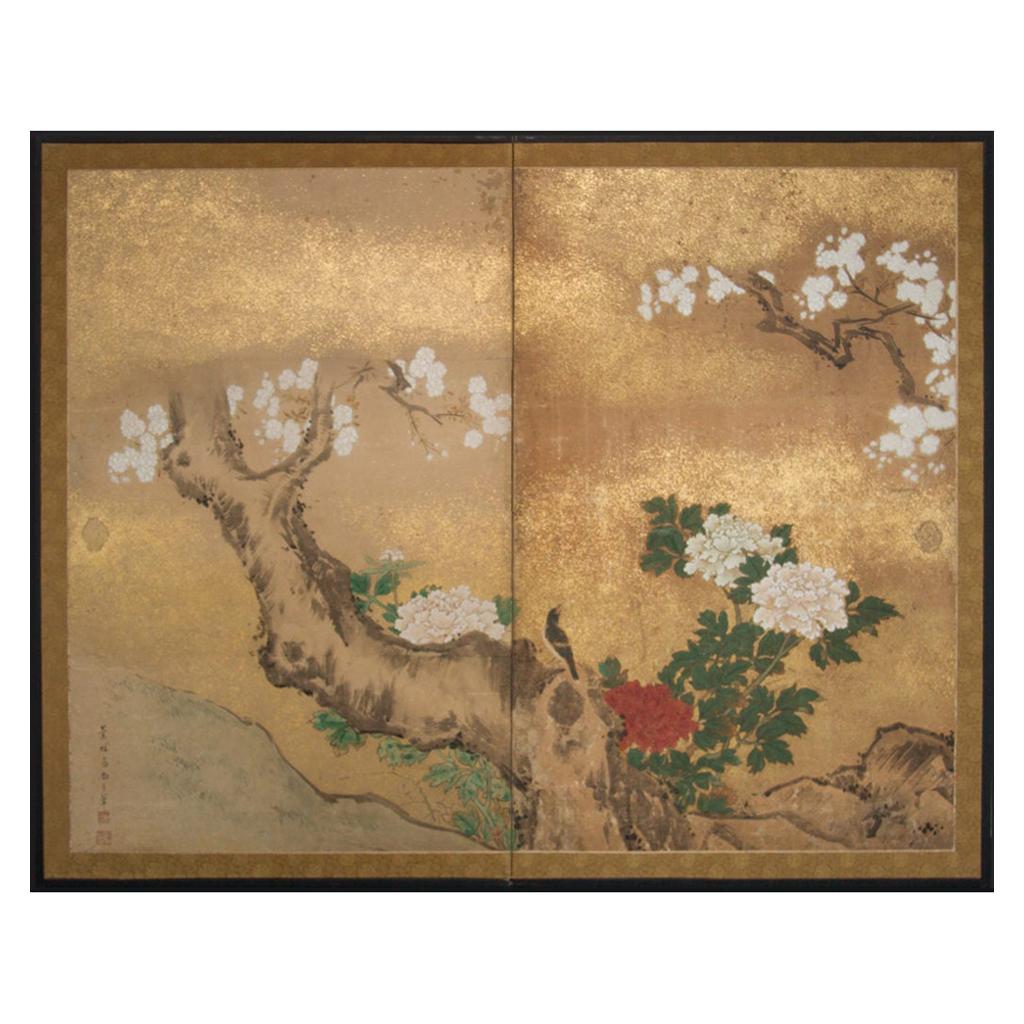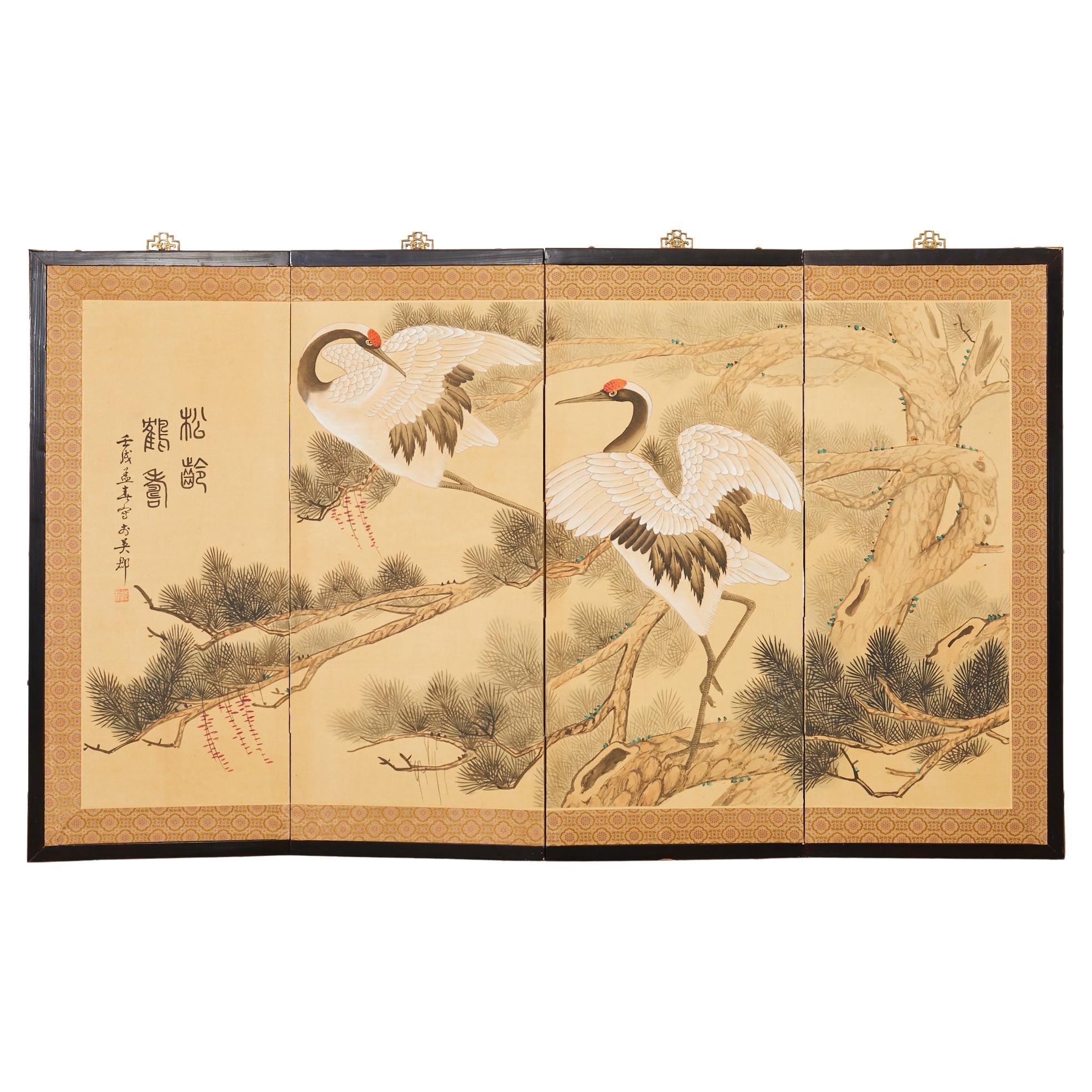Items Similar to Japanese Two Panel Screen Manchurian Crane and Turtles
Want more images or videos?
Request additional images or videos from the seller
1 of 14
Japanese Two Panel Screen Manchurian Crane and Turtles
About the Item
In Japan, cranes symbolize fidelity as they mate for life and turtles symbolize longevity. Additionally, this screen also has the Japanese motif of sho-chiku-bai, or the three friends of winter (pine, plum, and bamboo). So called the three friends of winter because all three flourish during the cold months. This screen was originally fusuma doors for either a temple or an important household due to evidence of very large door pulls. Kano school painting in mineral pigments, including an invigorating green and blue, on mulberry paper with a black frame.
- Dimensions:Height: 67 in (170.18 cm)Width: 63.25 in (160.66 cm)Depth: 0.75 in (1.91 cm)
- Style:Edo (Of the Period)
- Materials and Techniques:
- Place of Origin:
- Period:
- Date of Manufacture:circa 1850
- Condition:Most items that are 100 years old have been cleaned or polished in their lifetime. More involved restorations are mentioned in the above description. For a detailed condition report and a video of this item please contact us directly. -Naga Antiques.
- Seller Location:Hudson, NY
- Reference Number:
About the Seller
5.0
Recognized Seller
These prestigious sellers are industry leaders and represent the highest echelon for item quality and design.
Established in 1971
1stDibs seller since 2008
149 sales on 1stDibs
Typical response time: 8 hours
Associations
The Art and Antique Dealers League of AmericaAntiques Associations Members
- ShippingRetrieving quote...Ships From: Craryville, NY
- Return PolicyThis item cannot be returned.
More From This SellerView All
- Japanese Two Panel Screen Amorous Cranes and TurtlesLocated in Hudson, NYJapanese two panel screen: Amorous Cranes and Turtles. In Japan, cranes symbolize fidelity as they mate for life and turtles symbolize longevity. Additionally, this screen also has the Japanese motif of sho-chiku-bai, or the three friends of winter (pine, plum, and bamboo). So called the three friends of winter because all three flourish during the cold months. This screen was originally fusuma doors...Category
Antique 1850s Japanese Edo Paintings and Screens
MaterialsWood, Paper
- Japanese Two Panel Screen: Bamboo and Manchurian CraneLocated in Hudson, NYKano style painting in mineral pigments on silk with a silk brocade border.Category
Early 20th Century Japanese Paintings and Screens
MaterialsBrocade, Silk
- Japanese Two-Panel Screen: Cranes on GoldLocated in Hudson, NYEarly Kano School painting of pine trees overlooking two beautifully painted cranes and floral design in a natural setting by water’s edge. Mineral pig...Category
Antique Late 18th Century Japanese Paintings and Screens
MaterialsGold, Gold Leaf
- Japanese Two-Panel Screen Peony and CherryLocated in Hudson, NYJapanese two-panel screen: Peony and Cherry, Edo period (circa 1800) painting, formerly fusuma (Japanese sliding doors), executed in the Kano school style, featuring a cherry tree in...Category
Antique Early 1800s Japanese Edo Paintings and Screens
MaterialsGold Leaf
- Japanese Two Panel Screen, TurkeysLocated in Hudson, NYMineral pigments on silk, mounted on a gold panel, in silk border. Signature and seal read: Yoho.Category
Early 20th Century Japanese Paintings and Screens
MaterialsSilk
- Japanese Two Panel Screen, ChrysanthemumsLocated in Hudson, NYBeautiful white chrysanthemums are emphasized by heavy gold on a soft floral landscape, while gold clouds create a striking and dream-like floral scene. Gold leaf and gofun with min...Category
Antique Early 18th Century Japanese Paintings and Screens
MaterialsGold, Gold Leaf
You May Also Like
- Japanese Showa Six Panel Screen Manchurian Crane Bamboo GroveLocated in Rio Vista, CAEnchanting Japanese Showa period six-panel byobu screen titled "Bamboo Forest-Immortal Together". The large screen depicts six manchurian cranes in a ...Category
20th Century Japanese Showa Paintings and Screens
MaterialsBrass
- Japanese Style Four Panel Screen Manchurian Cranes in PineLocated in Rio Vista, CACaptivating 20th century Japanese style byobu four-panel folding screen. The screen is titled ancient pine/longevity cranes signed on left side with an artist seal Ying Jun. The scre...Category
20th Century Chinese Chinese Export Paintings and Screens
MaterialsBrass
- Japanese Edo Two-Panel Screen Flowers of AutumnLocated in Rio Vista, CAImpressive early 19th century Japanese Edo period two-panel screen featuring flowering plants and grasses of autumn. Painted in the Tosa School style Bunka Bunsei period or Ogosho pe...Category
Antique 19th Century Japanese Edo Paintings and Screens
MaterialsSilk, Wood, Paper
- 17th Century Japanese Screen Pair, CranesLocated in Kyoto, JPCranes Anonymous, Kano School. Edo period, second half of the 17th century. Pair of six-panel screens. Ink, pigment gofun and gold l...Category
Antique 1670s Japanese Edo Paintings and Screens
MaterialsGold Leaf
- Japanese Edo Two Panel Screen Deities by Yokoyama KazanLocated in Rio Vista, CAWhimsical Japanese late Edo period two-panel screen circa 1800 by Yokoyama Kazan (Japanese 1784-1837). The screen depicts four of the seven Gods or deities ...Category
Antique 19th Century Japanese Edo Paintings and Screens
MaterialsBrass, Gold Leaf
- Japanese Meiji Two Panel Screen Geese and ReedsLocated in Rio Vista, CAFantastic Japanese late Meiji period two-panel byobu screen by Hashimoto Koshu. The large screen features two white geese amid brightly colored reeds. The symbolism of geese and reeds was introduced to Japan from China in the 13th century. This was a popular subject for Japanese zen artists of the period. Beautifully crafted with exceptional brush strokes and details. Made with natural pigments in dramatic vivid colors of white, pink, and mint green on a silk background of gilt. Circa 1900 with artist seal on bottom right corner. Koshu studied Western art under...Category
20th Century Japanese Meiji Paintings and Screens
MaterialsSilk, Wood, Paper

